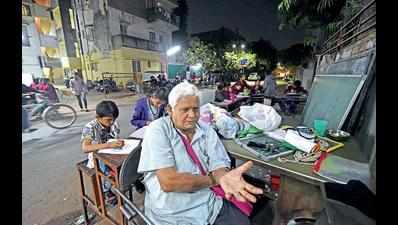- News
- City News
- ahmedabad News
- Ahmedabad: Footpath lessons on citizenship
Trending
This story is from February 1, 2019
Ahmedabad: Footpath lessons on citizenship

Kamal Parmar at his ‘footpath school’ in Bhudarpura on Thursday
AHMEDABAD: At the middle of a Bhudarpura residential colony, it’s never hard to find the famous ‘footpath school’ run by 72-year-old Kamal Parmar. Having studied till just class VII himself, Parmar had a different aim when he started the footpath school 18 years ago.
“I began this school because I was concerned at the poor quality of education, which is a major concern and has led to us having poor, uninformed, illiterate citizens,” Parmar says.
At least thrice a month, Parmar and one of his senior students, gather the teenagers among his 115 students and lecture them on citizenship, the importance of January 26 — the day the Constitution of India came into force in 1950.
“I tell them about ‘Prajasata’ (people’s power) which is about power to the people and how we all became equal under one flag, one law, irrespective of caste, creed, gender, class or colour, on January 26,” says Parmar.
“I tell them that January 26 is about rising above your biases and standing up for your fellow citizens, respecting each other and one’s neighborhood. That’s why we gave ourselves one Constitution and one flag on January 26, 1950.”
Most of the children who come to Parmar’s school are between 5 and 16 years old and live in the nearby slums of Ambedkar Colony, Mehnatpura and Sukhipura. At his school, every child is given the responsibility of serving other children, be it teaching the weaker ones arthmetic or the
“In two hours, children learn to be patient with others and take responsibility. This exercise is repeated every day.”
On why he began the school, he says, “Eighteen years ago I was standing outside my fabrication unit and saw 10-odd students of a municipal school going home. They were happy as their exams had ended. I called out to them and asked them a few questions. I was stunned that none of them knew how to read or write,” he says.
“The problem is the illiteracy among our masses. ‘Prajasata’ has no meaning if our masses are illiterate and uninformed,” Parmar says.
“I began this school because I was concerned at the poor quality of education, which is a major concern and has led to us having poor, uninformed, illiterate citizens,” Parmar says.
At least thrice a month, Parmar and one of his senior students, gather the teenagers among his 115 students and lecture them on citizenship, the importance of January 26 — the day the Constitution of India came into force in 1950.
“I tell them about ‘Prajasata’ (people’s power) which is about power to the people and how we all became equal under one flag, one law, irrespective of caste, creed, gender, class or colour, on January 26,” says Parmar.
He begins these citizenship classes with excerpts from Baba Saheb Ambedkar’s story, the princely states agreeing to join the Indian Union and why the Constitution was needed.
“I tell them that January 26 is about rising above your biases and standing up for your fellow citizens, respecting each other and one’s neighborhood. That’s why we gave ourselves one Constitution and one flag on January 26, 1950.”
Most of the children who come to Parmar’s school are between 5 and 16 years old and live in the nearby slums of Ambedkar Colony, Mehnatpura and Sukhipura. At his school, every child is given the responsibility of serving other children, be it teaching the weaker ones arthmetic or the
English alphabet, or serving the evening meal, which according to him, is citizenship in action.
“In two hours, children learn to be patient with others and take responsibility. This exercise is repeated every day.”
On why he began the school, he says, “Eighteen years ago I was standing outside my fabrication unit and saw 10-odd students of a municipal school going home. They were happy as their exams had ended. I called out to them and asked them a few questions. I was stunned that none of them knew how to read or write,” he says.
“The problem is the illiteracy among our masses. ‘Prajasata’ has no meaning if our masses are illiterate and uninformed,” Parmar says.
End of Article
FOLLOW US ON SOCIAL MEDIA










